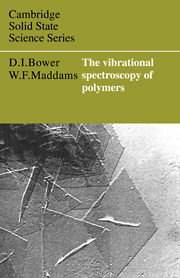Book contents
- Frontmatter
- Contents
- Preface
- 1 Introduction
- 2 Symmetry and normal modes of vibration
- 3 The vibrational modes of polymers
- 4 Infrared and Raman spectra
- 5 The characterization of polymers
- 6 The microstructure of polymers
- References for chapters 5 and 6
- A note on the use of the indexes
- Index of spectra illustrated
- Index of point groups
- Index of group modes
- Index of polymers
- Main index
2 - Symmetry and normal modes of vibration
Published online by Cambridge University Press: 05 May 2010
- Frontmatter
- Contents
- Preface
- 1 Introduction
- 2 Symmetry and normal modes of vibration
- 3 The vibrational modes of polymers
- 4 Infrared and Raman spectra
- 5 The characterization of polymers
- 6 The microstructure of polymers
- References for chapters 5 and 6
- A note on the use of the indexes
- Index of spectra illustrated
- Index of point groups
- Index of group modes
- Index of polymers
- Main index
Summary
Interatomic forces and molecular vibrations
Before considering the vibrations of polymers we shall consider those of isolated small molecules. The vibrational motion of such a molecule is independent of its overall translational motion and we shall neglect the effect of overall rotational motion of the molecule on its vibrational motion, since it can be shown that the two types of motion are independent to a good approximation. For polymers, particularly in the solid state, there is no significant rotational or translational motion of the molecules as a whole, but we shall see later, in chapter 3, that there are vibrational modes of crystalline polymers which are related to these types of motion.
When talking about the vibrations of a molecule it is convenient to consider the molecule to be a collection of atoms held together by chemical bonds. The atoms are imagined to be point masses and the bonds rather like springs, so that the whole assembly can vibrate as the masses move to and fro and the springs stretch and compress. This is the simple classical model that will be adopted in this chapter and it is worth a brief justification because at first sight it appears, when the true natures of the atoms and of the bonds are considered, to be rather far from the truth.
- Type
- Chapter
- Information
- The Vibrational Spectroscopy of Polymers , pp. 42 - 79Publisher: Cambridge University PressPrint publication year: 1989



